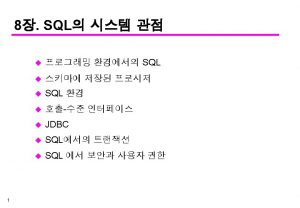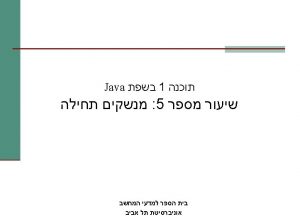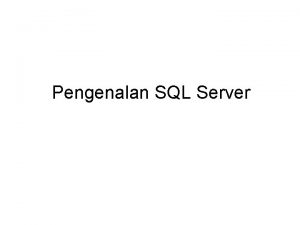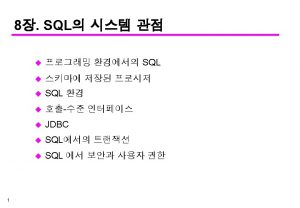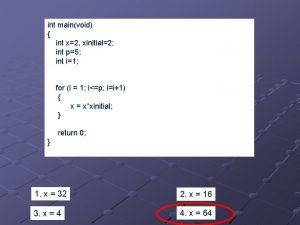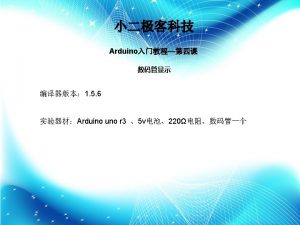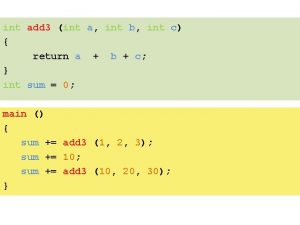SQL Server SCRIPTING USE Accounting DECLARE Ident int



















- Slides: 19

SQL Server SCRIPTING

ﺍﺳکﺮیپﺖ ﺩﺭﺝ ﻣﻘﺪﺍﺭ ﺩﺭ ﺟﺪﻭﻝ USE Accounting; DECLARE @Ident int; INSERT INTO Orders (Customer. No, Order. Date, Employee. ID) VALUES (g. ETDATE, 1); SELECT @Ident = @@IDENTITY; INSERT INTO Order. Details (Order. ID, Part. No, Description, Unit. Price, Qty) VALUES (@Ident, ‘ 2 R 2416’, ‘Cylinder Head’, 1300, 2); SELECT ‘The Order. ID of the INSERTed row is ‘ + CONVERT(varchar(8), @Ident);

SET ﺍﺯ ﺍﺳﺘﻔﺎﺩﻩ � USE Adventure. Works 2008; � DECLARE @Test money; � SET @Test = (SELECT MAX(Unit. Price) FROM Sales. Order. Detail) � SELECT @Test;

ﺍﻧﺘﺨﺎﺏ ﺑﺮﺍی SELECT ﺍﺳﺘﻔﺎﺩﻩ ﺍﺯ � USE Adventure. Works 2008; � DECLARE @Test money; � SELECT @Test = MAX)Unit. Price) FROM Sales. Order. Detail; � SELECT @Test;

SQL Server چﻨﺪ ﻣﺘﻐیﺮ ﺳیﺴﺘﻤی � @@ERROR � @@IDENTITY � @@REMSERVER � @@ROWCOUNT � @@SERVERNAME � @@TRANCOUNT � @@VERSION

USE Adventure. Works 2008; � � GO � DECLARE @RCount int; � SELECT * FROM Person; � � SELECT @RCount = @@ROWCOUNT;

Batch USE Adventure. Works 2008; DECLARE @My. Varchar varchar)50); --This DECLARE only lasts for this batch! SELECT @My. Varchar = ‘Honey, I’’m home; ’. . . PRINT ‘Done with first Batch; ’. . . GO PRINT @My. Varchar; --This generates an error since @My. Varchar -- isn’t declared in this batch PRINT ‘Done with second Batch; ’ GO PRINT ‘Done with third batch’; -- Notice that this still gets executed -- even after the error GO

ﻧﺘیﺠﻪ ﺍﺟﺮﺍی ﺍﺳکﺮیپﺖ ﻗﺒﻞ � Done with first Batch. . . � Msg 137, Level 15, State 2, Line 2 � Must declare the scalar variable “@My. Varchar. ” � Done with third batch

ﺟﺪﺍگﺎﻧﻪ ﻧﻮﺷﺘﻪ ﺷﻮﻧﺪ Batch ﺩﺳﺘﻮﺭﺍﺗی کﻪ ﺑﺎیﺪ ﺩﺭ � CREATE DEFAULT � CREATE PROCEDURE � CREATE RULE � CREATE TRIGGER � CREATE VIEW

� USE Test; � SELECT TABLE_CATALOG � FROM INFORMATION_SCHEMA. TABLES � WHERE TABLE_NAME = ‘Test. Table; ’

Command ﺍﺯ ﻃﺮیﻖ SQL ﺍﺟﺮﺍی ﺩﺳﺘﻮﺭﺍﺕ � C: >sqlcmd -Usa -Pmypass -i testsql. sql [ -d <db name> ] [ -o <output file> ] � � SQLCMD -Usa -Pmypass –Q “SELECT * FROM Adventure. Works 2008. Production. Locati on”

EXEC ﺍﺯ ﺍﺳﺘﻔﺎﺩﻩ ﻧکﺎﺕ runs under a separate scope than code that calls it � By default, it runs under the same security context as the current user � It runs under the same connection and transaction context as the calling object � Concatenation that requires a function call must be performed on the EXEC string prior to actually calling the EXEC statement � EXEC NOT Availabe inside a user-defined function. �


WAITFOR ﺩﺳﺘﻮﺭ � WAITFOR DELAY ‘ 01: 00’; � WAITFOR TIME ‘ 10: 00’;

IF NOT EXISTS ( SELECT s. name AS Schema. Name, t. name AS Table. Name FROM sys. schemas s � JOIN sys. tables t ON s. schema_id = t. schema_id � WHERE s. name = ‘dbo’ AND t. name = ‘Our. IFTest’) � � � CREATE TABLE Our. IFTest( � Col 1 int PRIMARY KEY); � SELECT ‘Found Table ‘ + s. name + ‘. ’ + t. name � FROM sys. schemas s � JOIN sys. tables t ON s. schema_id = t. schema_id � WHERE s. name = ‘dbo’ AND t. name = ‘Our. IFTest’;

� � � Use Adventure. Works 2008; GO SELECT TOP 10 Sales. Order. ID, Sales. Order. ID % 10 AS ‘Last Digit’, Position = CASE Sales. Order. ID % 10 � WHEN 1 THEN ‘First’ � WHEN 2 THEN ‘Second’ � WHEN 3 THEN ‘Third’ � WHEN 4 THEN ‘Fourth’ � ELSE ‘Something Else’ � � END FROM Sales. Order. Header;

� � � � � SELECT TOP 10 Sales. Order. ID % 10 AS ‘Order. Last. Digit’, Product. ID % 10 AS ‘Product. Last. Digit’, “How Close? ” = CASE WHEN (Sales. Order. ID % 10) < 3 THEN ‘Ends With Less Than Three’ WHEN Product. ID = 6 THEN ‘Product. ID is 6’ WHEN ABS(Sales. Order. ID % 10 - Product. ID) <= 1 THEN ‘Within 1’ ELSE ‘More Than One Apart’ END FROM Sales. Order. Detail ORDER BY Sales. Order. ID DESC;

ﺍﺳکﺮیپﺖ ﺩﺭ ﺧﻄﺎﻫﺎ ﻣﻬﺎﺭ � BEGIN TRY � { <sql statement(s)> } � END TRY � BEGIN CATCH � { <sql statement(s)> } � END CATCH [ ; ]

� � � � BEGIN TRY CREATE TABLE Our. IFTest(Col 1 int PRIMARY KEY); END TRY BEGIN CATCH DECLARE @Error. No int, @Severity tinyint, @State smallint, @Line. No int, @Message nvarchar(4000); SELECT @Error. No = ERROR_NUMBER(), @Severity = ERROR_SEVERITY(), @State = ERROR_STATE(), @Line. No = ERROR_LINE (), @Message = ERROR_MESSAGE(); IF @Error. No = 2714 PRINT ‘WARNING: Skipping CREATE as table already exists’; ELSE RAISERROR(@Message, 16, 1 ); END CATCH
 Sum0
Sum0 Int max(int x int y)
Int max(int x int y) Interface calculator public int add(int a int b) class test
Interface calculator public int add(int a int b) class test Public void drawsquare(int x, int y, int len)
Public void drawsquare(int x, int y, int len) Public int divide(int a int b)
Public int divide(int a int b) Declare an array alpha of 15 elements of type int
Declare an array alpha of 15 elements of type int Exec sql begin declare section
Exec sql begin declare section Exec sql begin declare section
Exec sql begin declare section Client side and server side
Client side and server side What is an ident?
What is an ident? Si ident
Si ident Sport ident
Sport ident Summary caption
Summary caption Interface myinterface int foo(int x)
Interface myinterface int foo(int x) Int main int argc char argv
Int main int argc char argv Nnxn com
Nnxn com Int factorial(int n)
Int factorial(int n) Const int arduino adalah
Const int arduino adalah Int main int num 4
Int main int num 4 Void swap
Void swap






